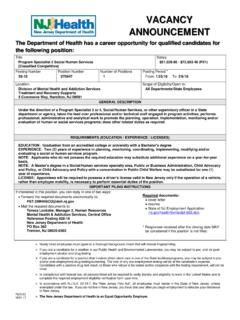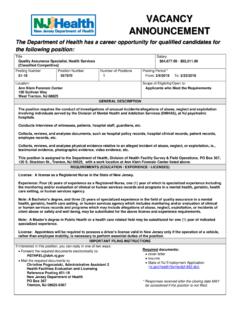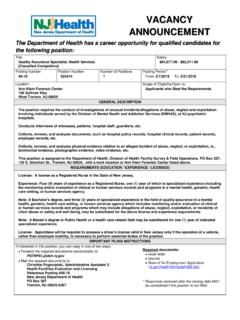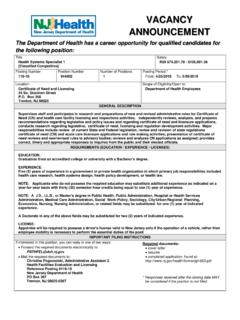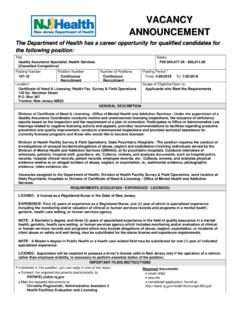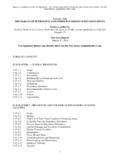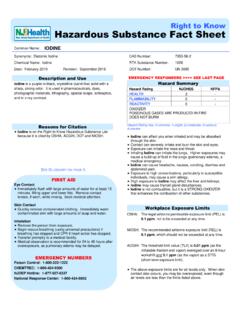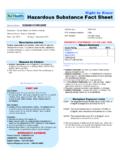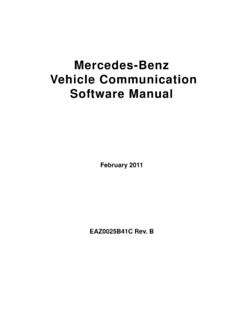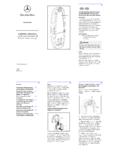Transcription of Right to Know Hazardous Substance Fact Sheet
1 Right to know Hazardous Substance fact Sheet Common Name: benz (a)ANTHRACENE Synonyms: Naphthanthracene; Tetraphene Chemical Name: benz [a]Anthracene Date: August 2008 Revision: November 2016 CAS Number: 56-55-3 RTK Substance Number: 0193 DOT Number: UN 3077 Description and Use benz (a)Anthracene is an odorless, colorless to yellow brown flake, plate or powder. It is not produced commercially, but is used in research laboratories. It is also found in Coal Tar, roasted coffee, smoked foods, and automobile exhaust, and is formed as an intermediate during chemical manufacturing. Reasons for Citation benz (a)Anthracene is on the Right to know Hazardous Substance List because it is cited by OSHA, ACGIH, DOT, NIOSH, NTP, DEP, IARC, and EPA. This chemical is on the Special Health Hazard Substance List. SEE GLOSSARY ON PAGE 5. FIRST AID Eye Contact Immediately flush with large amounts of water for at least 15 minutes, lifting upper and lower lids.
2 Remove contact lenses, if worn, while rinsing. Skin Contact Remove contaminated clothing and wash contaminated skin with soap and water. Inhalation Remove the person from exposure. Transfer promptly to a medical facility. EMERGENCY NUMBERS Poison Control: 1-800-222-1222 CHEMTREC: 1-800-424-9300 NJDEP Hotline: 1-877-927-6337 National Response Center: 1-800-424-8802 EMERGENCY RESPONDERS >>>> SEE BACK PAGE Hazard Summary Hazard Rating NJDHSS NFPA HEALTH 3 - FLAMMABILITY 1 - REACTIVITY 0 - CARCINOGEN POISONOUS GASES ARE PRODUCED IN FIRE Hazard Rating Key: 0=minimal; 1=slight; 2=moderate; 3=serious; 4=severe benz (a)Anthracene can affect you when inhaled. benz (a)Anthracene should be handled as a CARCINOGEN and MUTAGEN--WITH EXTREME CAUTION. For more information, consult the Right to know Hazardous Substance fact Sheet on COAL TAR PITCH. Workplace Exposure Limits OSHA: The legal airborne permissible exposure limit (PEL) is mg/m3 (as Coal Tar Pitch Volatiles, Benzene-soluble fraction) averaged over an 8-hour workshift.
3 NIOSH: The recommended airborne exposure limit (REL) is mg/m3 (as Coal Tar Pitch Volatiles, Cyclohexane-extractable fraction) averaged over a 10-hour workshift. ACGIH: Recommends that exposure by all routes be controlled to levels as low as possible. benz (a)Anthracene is a PROBABLE CARCINOGEN in humans. There may be no safe level of exposure to a carcinogen, so all contact should be reduced to the lowest possible level. benz (a)ANTHRACENE Page 2 of 5 Determining Your Exposure Read the product manufacturer s Material Safety Data Sheet (MSDS) and the label to determine product ingredients and important safety and health information about the product mixture. For each individual Hazardous ingredient, read the New jersey Department of Health Hazardous Substance fact Sheet , available on the RTK Program website ( ) or in your facility s RTK Central File or Hazard Communication Standard file. You have a Right to this information under the New jersey Worker and Community Right to know Act, the Public Employees Occupational Safety and Health (PEOSH) Act if you are a public worker in New jersey , and under the federal Occupational Safety and Health Act (OSHA) if you are a private worker.
4 The New jersey Right to know Act and the PEOSH Hazard Communication Standard ( 12:100-7) requires most employers to label chemicals in the workplace and requires public employers to provide their employees with information concerning chemical hazards and controls. The federal OSHA Hazard Communication Standard (29 CFR ) requires private employers to provide similar information and training to their employees. This fact Sheet is a summary of available information regarding the health hazards that may result from exposure. Duration of exposure, concentration of the Substance and other factors will affect your susceptibility to any of the potential effects described below. Health Hazard Information Acute Health Effects The following acute (short-term) health effects may occur immediately or shortly after exposure to benz (a)Anthracene: No acute (short-term) health effects are known at this time. Chronic Health Effects The following chronic (long-term) health effects can occur at some time after exposure to benz (a)Anthracene and can last for months or years: Cancer Hazard benz (a)Anthracene is a PROBABLE CARCINOGEN in humans.
5 There is evidence that it causes cancer in humans and it has been shown to cause liver and lung cancer in animals. Many scientists believe there is no safe level of exposure to a carcinogen. Such Substance may also have the potential for causing reproductive damage in humans. Reproductive Hazard According to the information presently available to the New jersey Department of Health, benz (a)Anthracene has not been tested for its ability to affect reproduction. Other Effects No chronic (long-term) health effects are known at this time. Medical Medical Testing There is no special test for this chemical. However, seek medical attention if illness occurs or overexposure is suspected. Any evaluation should include a careful history of past and present symptoms with an exam. Medical tests that look for damage already done are not a substitute for controlling exposure. Request copies of your medical testing. You have a legal Right to this information under the OSHA Access to Employee Exposure and Medical Records Standard (29 CFR ).
6 Workplace Controls and Practices Very toxic chemicals, or those that are reproductive hazards or sensitizers, require expert advice on control measures if a less toxic chemical cannot be substituted. Control measures include: (1) enclosing chemical processes for severely irritating and corrosive chemicals, (2) using local exhaust ventilation for chemicals that may be harmful with a single exposure, and (3) using general ventilation to control exposures to skin and eye irritants. For further information on workplace controls, consult the NIOSH document on Control Banding at The following work practices are also recommended: Label process containers. Provide employees with hazard information and training. Monitor airborne chemical concentrations. Use engineering controls if concentrations exceed recommended exposure levels. Provide eye wash fountains and emergency showers. Wash or shower if skin comes in contact with a Hazardous material.
7 Always wash at the end of the workshift. Change into clean clothing if clothing becomes contaminated. Do not take contaminated clothing home. Get special training to wash contaminated clothing. Do not eat, smoke, or drink in areas where chemicals are being handled, processed or stored. Wash hands carefully before eating, smoking, drinking, applying cosmetics or using the toilet. In addition, the following may be useful or required: Use a Class I, Type B, biological safety hood when mixing, handling, or preparing benz (a)Anthracene. Use a vacuum or a wet method to reduce dust during clean-up. DO NOT DRY SWEEP. Use a high efficiency particulate air (HEPA) filter when vacuuming. Do not use a standard shop vacuum. benz (a)ANTHRACENE Page 3 of 5 For more information, please contact: New jersey Department of Health Right to know Program PO Box 368 Trenton, NJ 08625-0368 Phone: 609-984-2202 Fax: 609-984-7407 E-mail: Web address: The Right to know Hazardous Substance fact Sheets are not intended to be copied and sold for commercial purposes.
8 Personal Protective Equipment The OSHA Personal Protective Equipment Standard (29 CFR ) requires employers to determine the appropriate personal protective equipment for each hazard and to train employees on how and when to use protective equipment. The following recommendations are only guidelines and may not apply to every situation. Gloves and Clothing Avoid skin contact with benz (a)Anthracene. Wear personal protective equipment made from material that can not be permeated or degraded by this Substance . Safety equipment suppliers and manufacturers can provide recommendations on the most protective glove and clothing material for your operation. Safety equipment manufacturers recommend Nitrile or Natural Rubber for gloves and DuPont Tyvek , or the equivalent, as a protective material for clothing. Eye Protection Wear eye protection with side shields or goggles. Respiratory Protection Improper use of respirators is dangerous.
9 Respirators should only be used if the employer has implemented a written program that takes into account workplace conditions, requirements for worker training, respirator fit testing, and medical exams, as described in the OSHA Respiratory Protection Standard (29 CFR ). Where the potential exists for exposure over mg/m3 (as Coal Tar Pitch Volatiles), use a NIOSH approved supplied-air respirator with a full facepiece operated in a pressure-demand or other positive-pressure mode. For increased protection use in combination with an auxiliary self-contained breathing apparatus operated in a pressure-demand or other positive-pressure mode. Exposure to 80 mg/m3 (as Coal Tar Pitch Volatiles) is immediately dangerous to life and health. If the possibility of exposure above 80 mg/m3 exists, use a NIOSH approved self-contained breathing apparatus with a full facepiece operated in a pressure-demand or other positive-pressure mode equipped with an emergency escape air cylinder.
10 Fire Hazards If employees are expected to fight fires, they must be trained and equipped as stated in the OSHA Fire Brigades Standard (29 CFR ). benz (a)Anthracene may burn, but does not readily ignite. Use dry chemical, CO2, water spray or foam as extinguishing agents. POISONOUS GASES ARE PRODUCED IN FIRE. Use water spray to keep fire-exposed containers cool. Spills and Emergencies If employees are required to clean-up spills, they must be properly trained and equipped. The OSHA Hazardous Waste Operations and Emergency Response Standard (29 CFR ) may apply. If benz (a)Anthracene is spilled, take the following steps: Evacuate personnel and secure and control entrance to the area. Eliminate all ignition sources. Moisten spilled material first or use a HEPA-filter vacuum for clean-up and deposit in sealed containers. Ventilate and wash area after clean-up is complete. DO NOT wash into sewer. It may be necessary to contain and dispose of benz (a)Anthracene as a Hazardous WASTE.
